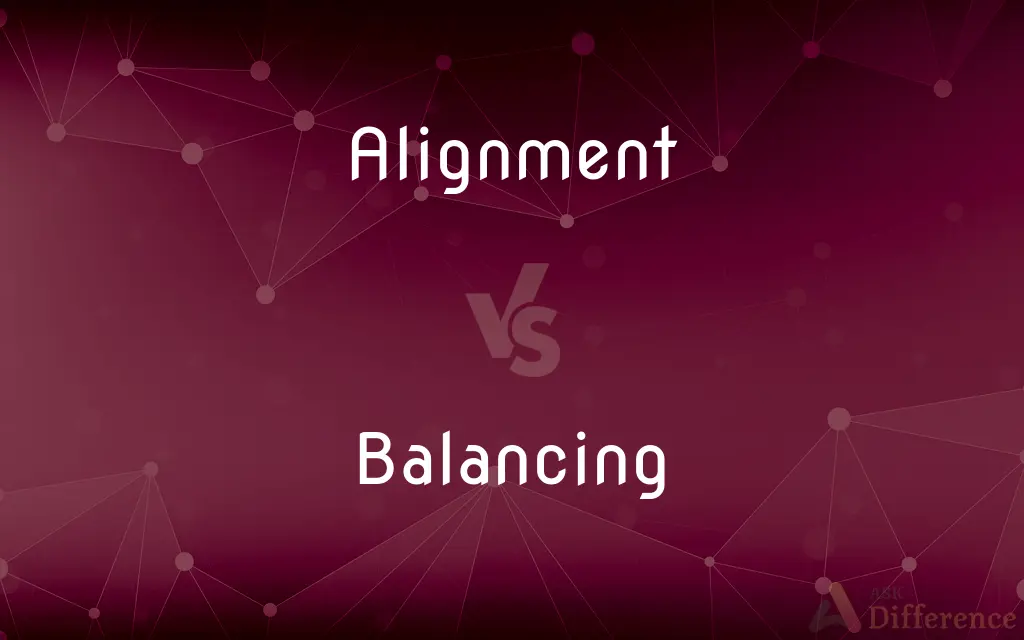Alignment vs. Balancing — What's the Difference?
By Fiza Rafique & Maham Liaqat — Published on March 6, 2024
Alignment ensures components are set in correct positions relative to each other for optimal operation, while balancing distributes weight evenly to prevent vibration and wear.

Difference Between Alignment and Balancing
Table of Contents
ADVERTISEMENT
Key Differences
Alignment refers to the process of adjusting the positions of components so that they are correctly positioned relative to each other, minimizing wear and ensuring efficient operation. On the other hand, balancing involves adjusting the distribution of weight within a rotating component or assembly to minimize vibration, reduce wear, and improve lifespan.
Poor alignment in machinery can lead to increased friction, premature wear of parts, and energy inefficiency, highlighting the importance of precise alignment for operational efficiency. Conversely, an imbalance in rotating equipment can cause excessive vibration, leading to damage not only to the machine itself but also potentially to adjacent structures and other machinery.
Alignment is often a critical step during the installation of machinery and may require periodic adjustments to maintain optimal performance due to factors like thermal expansion, settling, or wear. Balancing, while also sometimes done during initial setup, may need to be performed periodically as well, especially after parts replacement or if there are changes in the operating environment that could affect the balance.
Techniques for alignment vary from simple visual inspection and use of straight edges to sophisticated laser alignment tools, depending on the precision required and the complexity of the machinery. Balancing, on the other hand, may involve adding or removing material from the rotating parts or using balancing weights and is often performed with the aid of specialized balancing machines.
The goal of both processes is to enhance the lifespan and efficiency of machinery. Proper alignment ensures that forces are distributed evenly across components, reducing strain and energy consumption, whereas effective balancing reduces the risk of vibration-related issues, enhancing the stability and reliability of the equipment.
ADVERTISEMENT
Comparison Chart
Objective
Correct positioning of components
Even weight distribution
Main Benefit
Minimizes wear, enhances efficiency
Reduces vibration, prevents wear
When It's Performed
During installation, periodic maintenance
Initial setup, after parts replacement
Techniques Used
Visual inspection, laser tools
Adding/removing material, balancing weights
Impact on Machinery
Reduces friction and wear
Enhances stability, reduces risk of damage
Compare with Definitions
Alignment
Alignment ensures machine parts are correctly positioned.
Laser alignment was used to ensure the motor and pump shafts were in line.
Balancing
Balancing involves evening out weight distribution in rotating parts.
The fan was balanced to eliminate vibration.
Alignment
It is crucial for operational efficiency.
Correct alignment of the gears resulted in smoother operation.
Balancing
It is key to preventing vibration and wear.
Balancing the new spindle ensured it ran smoothly without excess vibration.
Alignment
Proper alignment reduces machinery wear.
Regular alignment checks help extend the conveyor belt's life.
Balancing
Balancing can extend machinery life.
Properly balancing the rotors prevented premature bearing failure.
Alignment
Alignment minimizes energy consumption.
Ensuring the shafts were aligned reduced the motor's power usage.
Balancing
It may require adding or removing material.
Weights were added to the flywheel for better balance.
Alignment
Periodic alignment adjustments are necessary.
The production line's alignment is checked quarterly to prevent issues.
Balancing
Specialized balancing machines are often used.
The auto-shop used a balancing machine to balance the car's wheels.
Alignment
Arrangement or position in a straight line or in parallel lines.
Balancing
A weighing device, especially one consisting of a rigid beam horizontally suspended by a low-friction support at its center, with identical weighing pans hung at either end, one of which holds an unknown weight while the effective weight in the other is increased by known amounts until the beam is level and motionless. Also called scale.
Alignment
The process of adjusting parts so that they are in proper relative position
A set of gears needs periodic alignment.
Balancing
A state of equilibrium or parity characterized by cancellation of all forces by equal opposing forces.
Alignment
The condition of having parts so adjusted
Binocular lenses that are out of alignment will yield a double image.
Balancing
A state of bodily equilibrium
Thrown off balance by a gust of wind.
Alignment
The process of adjusting a mechanism such that its parts are aligned; the condition of having its parts so adjusted.
Balancing
To determine the weight of (something) in a weighing device.
Alignment
The act of adjusting to a line; arrangement in a line or lines; the state of being so adjusted; a formation in a straight line; also, the line of adjustment; esp., an imaginary line to regulate the formation of troops or of a squadron.
Balancing
To bring into or keep in equal or satisfying proportion or harmony.
Alignment
The act of adjusting or aligning the parts of a device in relation to each other
Balancing
To be equal or equivalent.
Balancing
Getting two things to correspond;
The reconciliation of his checkbook and the bank statement
Common Curiosities
How does balancing benefit rotating equipment?
It minimizes vibration, enhancing stability and lifespan.
What techniques are used for balancing?
Adding or removing material, using balancing weights and machines.
What is the main purpose of alignment in machinery?
To correctly position components for optimal operation and efficiency.
What are the consequences of poor alignment?
Increased friction, premature wear, and reduced efficiency.
What tools are used for alignment?
From simple straight edges to sophisticated laser alignment tools.
Why is alignment important for new machinery installations?
To ensure machinery runs efficiently and with minimal wear from the start.
What factors can affect the alignment and balance of machinery over time?
Thermal expansion, settling of foundations, wear and tear, and operational impacts.
Can balancing affect the energy efficiency of machinery?
Yes, by reducing vibration and wear, it can lead to more efficient operation.
How do environmental conditions affect machinery alignment and balancing?
Changes in temperature, humidity, and operational loads can necessitate adjustments.
How often should balancing be checked or adjusted?
Periodically, especially after replacing parts or if changes in vibration are noticed.
When should machinery alignment be performed?
During installation and periodically for maintenance.
How does improper balancing impact adjacent machinery?
Vibration can transmit, causing wear and potential damage to nearby equipment.
What is the relationship between alignment and balancing in terms of machinery maintenance?
Both are crucial for the optimal performance and longevity of machinery, addressing different aspects of mechanical efficiency.
Can alignment and balancing reduce operational costs?
Yes, by minimizing wear, reducing downtime, and saving on energy costs.
Is it possible to correct imbalance without specialized equipment?
While minor adjustments can be made, specialized equipment ensures precision and effectiveness.
Share Your Discovery

Previous Comparison
Acetone vs. Paint Thinner
Next Comparison
Magnetic Force vs. Electric ForceAuthor Spotlight
Written by
Fiza RafiqueFiza Rafique is a skilled content writer at AskDifference.com, where she meticulously refines and enhances written pieces. Drawing from her vast editorial expertise, Fiza ensures clarity, accuracy, and precision in every article. Passionate about language, she continually seeks to elevate the quality of content for readers worldwide.
Co-written by
Maham Liaqat












































